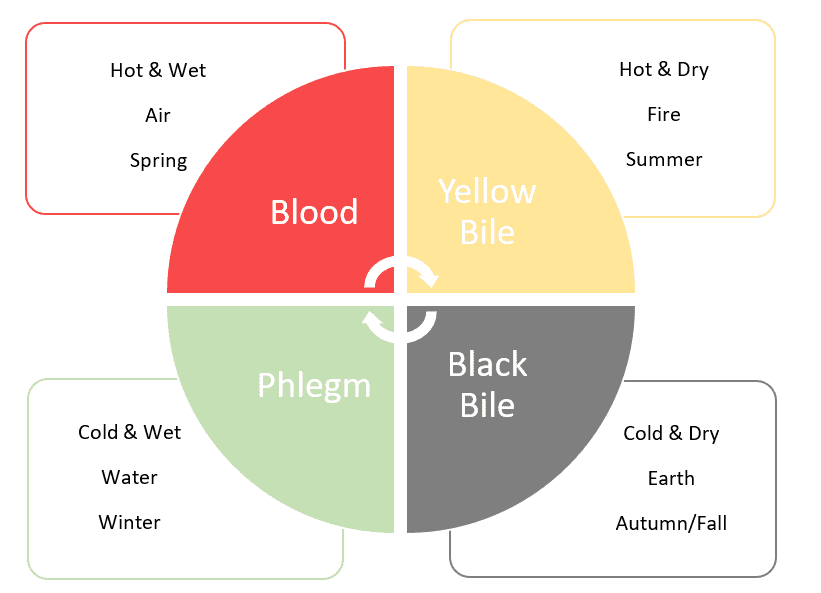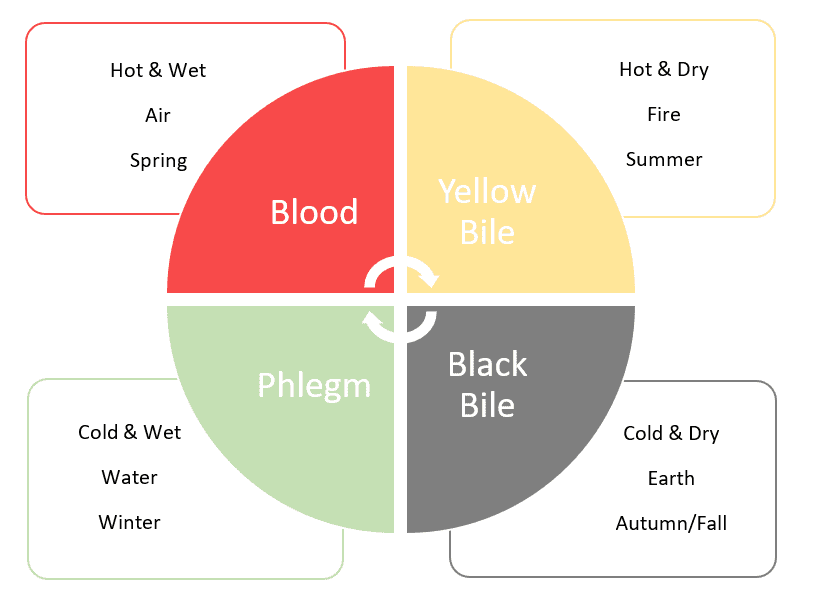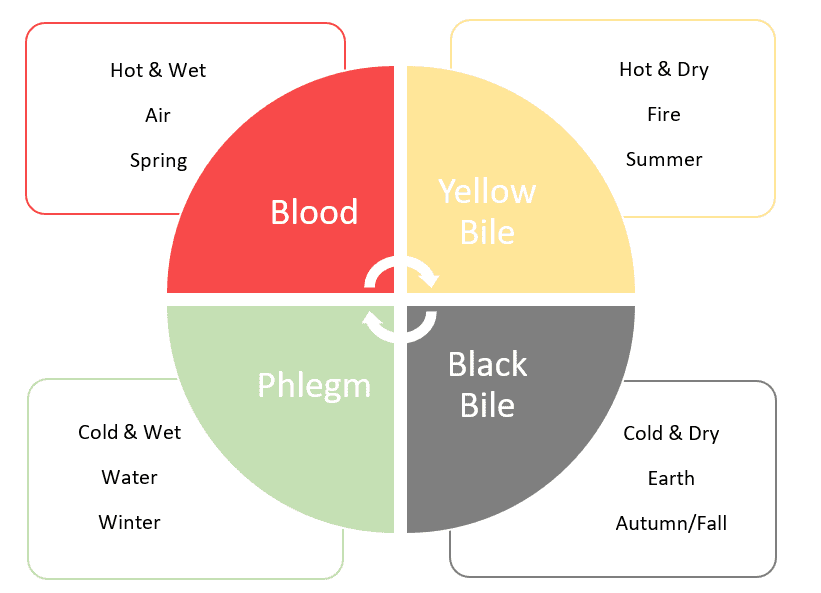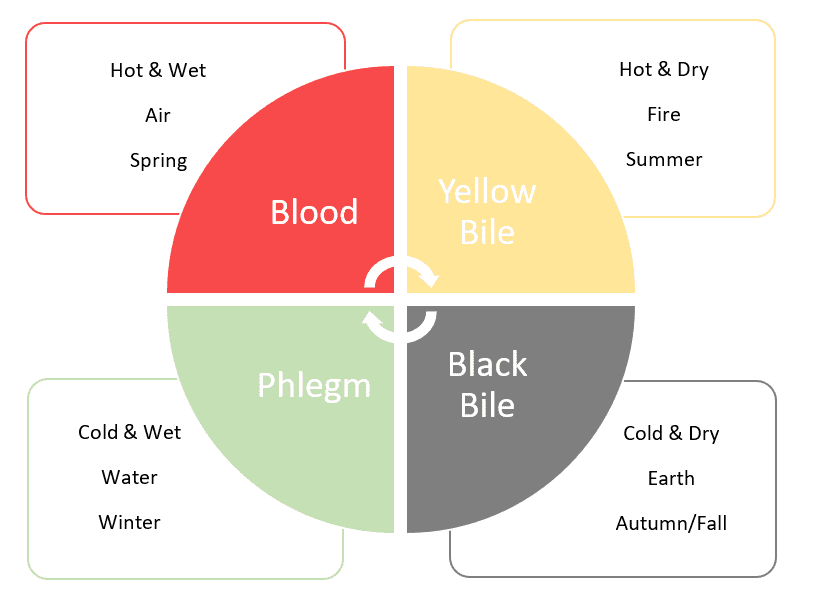People's Health: Medieval Britain 1250-1500
1/68
There's no tags or description
Looks like no tags are added yet.
Name | Mastery | Learn | Test | Matching | Spaced |
|---|
No study sessions yet.
69 Terms
What were some religious responses to diseases like the Black Plague?
-Priests urged people to confess their sins
-Some ate holy bread blessed by the priest at special church services
-Processions of priests through cities confessing the nations sins
-Flagellants whipped each other so that God could see their love and self-sacrifice
What elements, seasons and foods are the four humours associated with?
Blood- Air
Yellow Bile- Fire
Black Bile- Earth
Phlegm- Water




What were houses like in the countryside?
What was medieval housing like in the countryside?
One storey house
Thatched roof
Full of people and animals (separated)
Stone hearth (fire place)
Wattle and daub (Walls woven with sticks and mud)
Rooms were dark and smoky
How did people manage waste in the countryside?
Would use a midden (rubbish tip)
Cesspits which could overflow
Waste used to fertilise soil
What was food in the countryside like?
Mill ground grain
Pottage (Thick vegetable soup)
Peas, beans and onions
Possibly fish on Friday
Damp conditions could lead to fungus growing on bread
What was water like in the countryside?
Villages were near streams and springs
Water was often polluted by animals who excreted in it
Drank water as well as cider and mead
Peasants bathed in streams
Fulling polluted streams as fullers cleaned cloth using urine
What was housing like in towns?
Upper floors would jut out
thatched roofs
People would plant flowers to get rid of miasma
People planted vegetables and pigs would fertilise them
Very cramped
How did people manage waste in towns?
Gong Fermers would remove excrement from latrines
People used public latrines and would share them with many people
What was water like in towns?
Some had their own wells
No pipes for clean water except in conduits
Water was used for cooking, washing food, brewing ale
Fountains
Water could be obtained from a water carrier who brought it to your home if you were rich
Could buy from water sellers
What was food like in towns?
Sugar was rare and expensive so honey was used instead
Peasants used carts that took rubbish from the midden to carry grain, fruit, fish, cheese, timber and cloth
Market allowed access to food you wouldn’t normally find such as meat, spices, fish, and sugar
What did medieval people drink more than water?
Mead
Why was it cleaner to drink from a well than a stream?
Because stream water was dirty
What were people that worked on the land called?
Peasants
What was ergotism also known as?
St Anthony’s Fire
What was ergotism?
A disease caused by consuming infected rye grains
Causes headache, vomiting, diarrhoea, and gangrene of the fingers and toes
What percentage of the population died in the Great Famine of 1315-16?
10% of the population
What year did the Black Death come to England?
1348
How did the Black Death arrive in England?
Through fleas on rats that were on ships that travelled to Britain’s ports
What types of plague were there?
Bubonic, pneumonic, septicaemic
What were the symptoms of the bubonic plague?
Buboes swelling on the armpits or groin
Blood loss
Death in five days
What are the symptoms of the pneumonic plague?
Coughing up blood
Chest pains
Death in three days
What are the symptoms of the septicaemic plague?
Fever, chills, extreme weakness, abdominal pain
How many people did the Black Death kill between 1348 -49?
One third of the population
What lotion did people use to soothe the skin?
Camomile lotion
What was the most common treatment for the Black Death using the humours?
Blood-letting
What did doctors in this time period not know?
They didn’t know that germs existed so they didn’t understand the importance of infection, cleanliness and contagion
How did septicaemic plague develop?
If someone who had a bad case of the bubonic plague had their bloodstream poisoned
What did poor living conditions lead to?
Diseases spreading quickly because of the houses cramped with people and animals
Malnutrition made it easier for people to catch diseases
Life expectancy was very poor and many died young
What is dysentery?
An infection of the intestines that causes diarrhoea containing blood or mucus
What did believers in astrology do to defend themselves from the plague?
They carried diamonds and rubies to to protect them
What did Edward III do in 1349?
He told the Lord Mayor of London to remove filth from the streets, in hope of removing bad smells
What did some communities do to get rid of traces of the Black Death?
They burned clothes of the victims, which would have killed the bacteria as well
What religion were most people in Medieval England?
Catholic
What percentage of people lived in the countryside?
90%
What was the largest industry in Medieval England?
The wool industry
How would some people try to treat the buboes caused by the plague?
Put live toads on buboes to soften them
What were Jews accused of relating to the Black Death?
They were accused of poisoning water supplies and were burnt
What did butchers, tanners and dyers do to contribute to unsanitary conditions?
They threw toxic waste into rivers and residential areas
How did Gloucester try to defend itself from plague?
It shut itself off from the outside but this was unsuccessful as many people in the town died of the Black Death
How many towns had a population of 10,000 by 1500?
15
What was the only big city?
London- tens of thousands of people lived there
What was built in 1230 in London?
The Great Conduit which was built to bring in clean water to London as the Thames was getting too toxic
What did the government do in 1388?
It ordered town authorities to keep the streets free of waste
Public health measures implemented to get rid of waste, sewage and pollution
What did towns like York do to butchers, fishmongers and tanners?
To move their businesses outside the city walls as they were too unsanitary
What did York and London do to improve how waste was removed?
Dumping waste in streets to be picked up by scavengers
They also built latrines over water so that sewage could be carried away
How were monasteries healthier than towns?
They had cleaner water and better systems for removing waste
They knew how to grow herbs and make herbal remedies
Separated clean and dirty water into water used for drinking and cooking and the other being drainage and washing
Monasteries were built near rivers to supply clean water
Monasteries had infirmaries and and kitchens that served good meals to help the sick recover
Hospitals cared for poor people who were sick and gave shelter to travellers
Latrines were in separate buildings over streams of running water
What did medieval people bathe in to get rid of boils from the Black Death?
They thought bathing in urine would help get rid of the boils and make them feel better
Why were monasteries cleaner?
The were wealthy and could afford to build infrastructure like latrine buildings
The Abbot was the only one in charge so it was easier to enforce rules about cleanliness
How did Carlisle improve their town?
There were no measures taken as the town could not afford to clean the mess
Many diseases killed livestock and people
How did Shrewsbury improve their town?
King Edward III gave permission to pave the streets using money from the wealthy
Trade improved and the roads were not filled with filth
How did Bristol improve their town?
They moved dung heaps, lepers and prostitutes outside the town
The town because cleaner because the dung heaps were on the outskirts of the city but everything else was useless
What happened to Exeter’s water supply by 1180?
Monks at the cathedral brought piped water from a spring
The pipes supplied the cathedral and a small priory with water
Another section of pipe ran to the main crossroads to the town centre
What happened to Exeter’s water supply in the 1240s?
Someone had the idea of making a passage or vault through the most thickness of the wall
This meant the pipe could be reached for maintenance without digging away the wall each time
What happened to Exeter’s water supply in the 1340s?
The Church paid for a construction of a lengthy underground passage to carry the lead pipe
This passage was being finished just as the Black Death struck Exeter
What happened to Exeter’s water supply in the 1420s?
New work was organised and paid for by the town council
Two rich ex-mayors left money in their wills to improve water supply
Two new street conduits were built
What happened to Exeter’s water supply in the 1440s-50s?
The cathedral and town council helped to fund the work of improving Exeter’s water supply
English towns were gaining influence and wealth
1450s-the town was rich enough to employ a full time plumber
King Henry VI visited in 1451
What happened to Exeter’s water supply by 1500?
Exeter was again extending it’s underground passageways to secure it’s water supply
The aim was to lay pipe in a passage below the main bridge
This would help Exeter’s trade if workmen could easily repair a burst water pipe without having to dig up the road